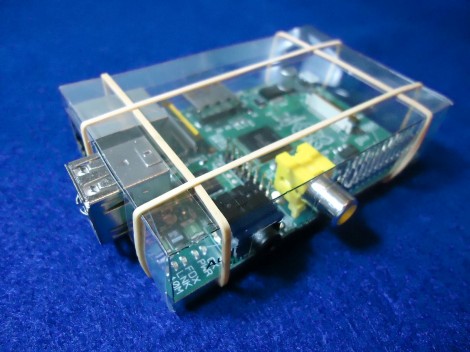
This flimsy case isn’t going to protect your Raspberry Pi if you knock it off the workbench. It will provide a level of protection against shorting out from contact with metal objects, or from liquids spilled in the near vicinity. [CGPatterson] ended up making this case from a single sheet of transparency film.
The project is basically papercraft. He started with the dimensions published on the Raspberry Pi FAQ, which turned out to be wrong. Not having a caliper available to help with the precision of the measurements, he grabbed his ruler and did the best he could. The first two cases were a poor fit, but as you can see the third is like a glove. Luckily you don’t have to go through this same trial and error as he release the design. Both A4 and US Letter sized PDFs are available for download. Print them out on the transparency, cut along the lines, apply transparent double-sided tape to the tabs and you’re in business. If you wish to alter the design he has also posted the SVG source he made in Inkscape.
This is certainly a good option for those of us without the ability to produce laser cut parts.















This inspires me to do more papercraft using transparency film. It’s almost a no brainer but I never thought of it. Very cool idea and well executed. You could possibly make this more solid if you use pvc glue instead of tape. I think I’ll do some paper craft that way.
Why not do it from actual paper, and then just spray it down with laquer?
My recollection of transparency film is that it’s really good at building up static charge – which might not make it a great choice as an enclosure for a R-Pi?
It’s more of a function for how thin it is. It’s a good insulator, so a thin sheet will easily work like a capacitor. Pulling one out of the stack charges it up by mechanically by leaving one sheet charged positively on one side, and the other negative.
Aparantly, you can get anything on HaD if there is a Raspberry Pi in it, on it, connected to it, stapled to it, or near it.
Heh yeah, it has truly replaced the arduino now
I restrained myself from posting that on a previous article, but I just can’t help it for this. Thirty seconds with scissors and tape gets you to Hackaday now, as long as a Rasduino is involved somehow.
Got the email today from Allied to order a Raspberry Pi, the ONE day I don’t have the money.
Don’t feel too bad; it’s still a twelve week wait.
Are you sure that isn’t a cassette case? Because it sure looks like one.
To borrow a meme from slashdot…
#1 Fold transparency sheet….
#2 Put Raspberry Pi inside….
#3 ????
#4 Profit!!!
I’m glad I’m not the only one pointing out that this junk is diluting the content of this otherwise awesome site.
That would be South Park. And this is cool, not junk.
It’s true that it’s a bit simplistic to be a “proper” hack, but it has nice touches: both square and round cutouts for plugs (so if you have a punch, you can get a nice tight round cut, if not you can cut a clean square with a stanley blade), and the fact that by printing the template, he took advantage of printing name tags for each slot/plug/socket.
I guess that if you’re concerned about static electricity, you could always sacrifice an antistatic bag, cut it open and stick it to the printed transparency prior to cutting (e.g. with double sided tape?).
While you’re at it, you could also personalise the top of the “box” in the PDF prior to printing.
I don’t think those bags work that way.